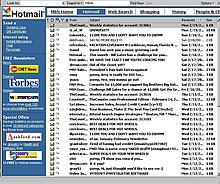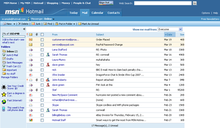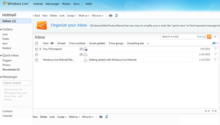Launch of Hotmail
Hotmail service was founded by Sabeer Bhatia and Jack Smith and was one of the first webmail services on the Internet along with Four11's RocketMail (later Yahoo! Mail). It was commercially launched on July 4, 1996, symbolizing "freedom" from ISP-based email and the ability to access a user's inbox from anywhere in the world. The name "Hotmail" was chosen out of many possibilities ending in "-mail" as it included the letters HTML, the markup language used to create web pages (to emphasize this, the original type casing was "HoTMaiL"). The limit for free storage was 2 MB. Hotmail was initially backed by venture capital firm Draper Fisher Jurvetson. By December 1997, it reported more than 8.5 million subscribers.[12] Hotmail initially ran under Solaris for mail services and Apache on FreeBSD for web services, before being partly converted to Microsoft products, using Windows Services for UNIX in the migration path.
MSN Hotmail
Hotmail was sold to Microsoft in December 1997 for a reported $400 million, and it joined the MSN group of services. Hotmail quickly gained in popularity as it was localized for different markets around the globe, and became the world's largest webmail service with more than 30 million active members reported by February 1999. Hotmail originally ran on a mixture of FreeBSD and Solaris operating systems. A project was started to move Hotmail to Windows 2000. In June 2001, Microsoft claimed this had been completed; a few days later they retracted and admitted that the DNS functions of the Hotmail system were still reliant on FreeBSD. In 2002 Hotmail still ran its infrastructure on UNIX servers, with only the front-end converted to Windows 2000. Later development saw the service tied with Microsoft's web authentication scheme, Microsoft Passport (now Microsoft account), and integration with Microsoft's instant messaging and social networking programs, MSN Messenger and MSN Spaces (later Windows Live Messenger and Windows Live Spaces, respectively).
Security issues
In 1999, hackers revealed a security flaw in Hotmail that permitted anybody to log in to any Hotmail account using the password 'eh'. At the time it was called "the most widespread security incident in the history of the Web". In 2001, the Hotmail service was compromised again by computer hackers who discovered that anyone could log in to their Hotmail account and then pull messages from any other Hotmail account by crafting a URL with the second account's username and a valid message number. It was such a simple attack that by the time the patch was made, dozens of newspapers and hundreds of web sites published exact descriptions allowing tens of thousands of hackers to run rampant across Hotmail. The exploitable vulnerability exposed millions of accounts to tampering between August 7, 2001, and August 31, 2001.
Competition
In 2004, Google announced its own mail service, Gmail. Featuring greater storage space, speed, and interface flexibility, this new competitor spurred a wave of innovation in webmail. The main industry heavyweights – Hotmail and Yahoo! Mail – introduced upgraded versions of their email services with greater speed, security, and advanced features.
Windows Live Hotmail
Microsoft's new email system was announced on November 1, 2005, under the codename "Kahuna", and a beta version was released to a few thousand testers. Other webmail enthusiasts also wanting to try the beta version could request an invitation granting access. The new service was built from scratch and emphasized three main concepts of being "faster, simpler, and safer". New versions of the beta service were rolled out over the development period, and by the end of 2006, the number of beta testers had reached the millions.
The Hotmail brand was planned to be phased-out when Microsoft announced that the new mail system would be called Windows Live Mail, but the developers soon backtracked after beta-testers were confused with the name change and preferred the already well-known Hotmail name, and decided on Windows Live Hotmail. After a period of beta testing, it was officially released to new and existing users in the Netherlands on November 9, 2006, as a pilot market. Development of the beta was finished in April 2007, Windows Live Hotmail was released to new registrations on May 7, 2007, as the 260 million MSN Hotmail accounts worldwide gained access to the new system. The old MSN Hotmail interface was accessible only by users who registered before the Windows Live Hotmail release date and had not chosen to update to the new service. The roll-out to all existing users was completed in October 2007.
Windows Live Hotmail was awarded PC Magazine's Editor's Choice Award in February 2007,[27] March 2007, and February 2011.
In 2008 it was announced that the service would be updated with a focus on improving the speed, increasing the storage space, better user experience, and usability features, and that sign-in and email access speeds would be up to 70 percent faster. The classic and full versions of Windows Live Hotmail were combined in the new release. As a result of user feedback, Hotmail was updated so that scrolling works for users who have the reading pane turned off. It was also expected that Hotmail team would be moving the advertisement from the top of the page to the side, adding more themes, increasing the number of messages on each page and adding the ability to send instant messages from the user's inbox in future releases.
Support for Firefox in the upgraded Windows Live Hotmail took a few months to complete. By 2009, support for Google Chrome was still incomplete, prompting the Chrome developers to temporarily ship a browser that employed user agent spoofing when making requests to the Windows Live site.
As part of the update, Microsoft also added the integrated capability for instant messaging with contacts on the Windows Live Messenger service. The feature was the realization of a project that began as "Windows Live Web Messenger" in 2007, a replacement for the outdated "MSN Web Messenger" service that was first introduced in August 2004. It was noted that the original "Windows Live Web Messenger" featured tabbed conversations in a "conversation workspace", however since its integration with Hotmail this has been removed.
Microsoft's search engine Bing was integrated into Hotmail in 2009 through the introduction of a "Quick Add" feature, allowing users to add search results from Bing into emails. These include images, maps and business listings.
On May 18, 2010, Microsoft unveiled the "Wave 4" update of Hotmail, which offered features such as 1-click filters, active views, inbox sweeping, and 10 GB space for photos, Microsoft Office documents, and attachments. It also included integration with Windows Live SkyDrive and Windows Live Office, a free version of Microsoft's Office Web Apps suite. The new version began its gradual release to all Hotmail users on June 15, 2010, and was completely rolled out on August 3, 2010. Exchange ActiveSync support was enabled to all Hotmail users on August 30, 2010, allowing users to sync their mail, contacts, calendar and tasks to their mobile devices that supports the protocol. Addition of full-session SSL was released on November 9, 2010.
Throughout 2011, Microsoft added several new features to Hotmail, such as aliases and speed improvements. In October 2011, Microsoft unveiled a "re-invented Hotmail", and added many new features such as Instant Actions, scheduled Sweep, and Categories and this update began fully rolling out on November 9, 2011. This update also made SSL enabled by default on all accounts.
Also read: liteblue Hotmail login



Webroot is a security software which is universally famous for giving best quality protection services. At Webroot Billing Support , you will get 24/7 assistance by qualified technicians.
ReplyDelete